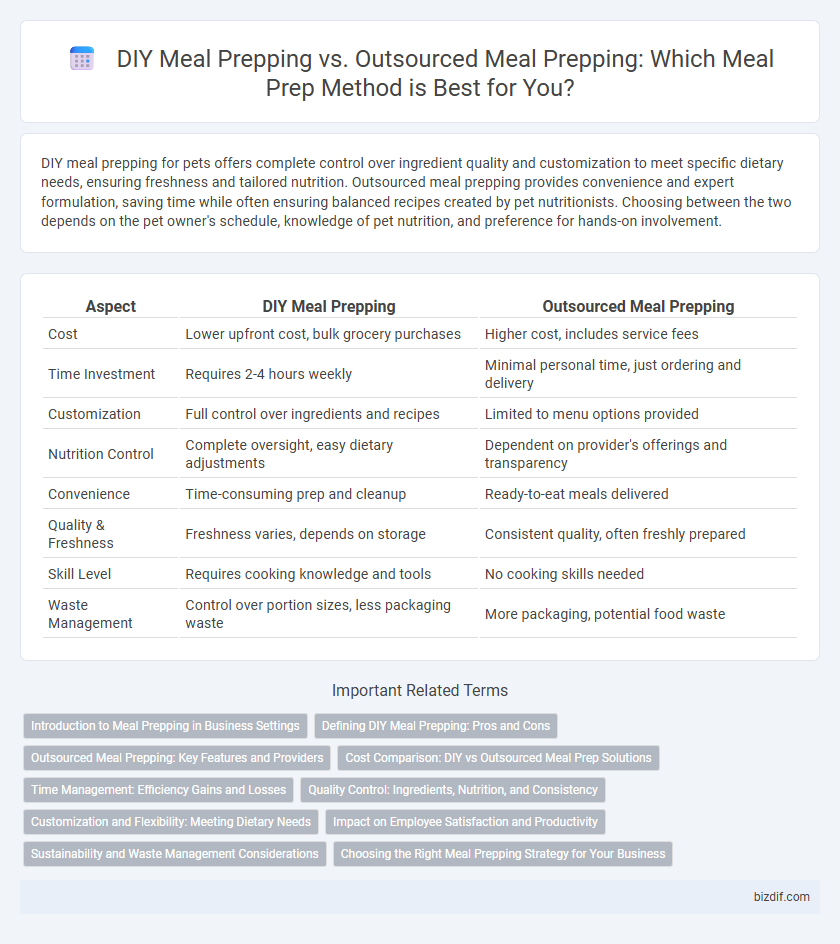DIY meal prepping for pets offers complete control over ingredient quality and customization to meet specific dietary needs, ensuring freshness and tailored nutrition. Outsourced meal prepping provides convenience and expert formulation, saving time while often ensuring balanced recipes created by pet nutritionists. Choosing between the two depends on the pet owner's schedule, knowledge of pet nutrition, and preference for hands-on involvement.
Table of Comparison
| Aspect | DIY Meal Prepping | Outsourced Meal Prepping |
|---|---|---|
| Cost | Lower upfront cost, bulk grocery purchases | Higher cost, includes service fees |
| Time Investment | Requires 2-4 hours weekly | Minimal personal time, just ordering and delivery |
| Customization | Full control over ingredients and recipes | Limited to menu options provided |
| Nutrition Control | Complete oversight, easy dietary adjustments | Dependent on provider's offerings and transparency |
| Convenience | Time-consuming prep and cleanup | Ready-to-eat meals delivered |
| Quality & Freshness | Freshness varies, depends on storage | Consistent quality, often freshly prepared |
| Skill Level | Requires cooking knowledge and tools | No cooking skills needed |
| Waste Management | Control over portion sizes, less packaging waste | More packaging, potential food waste |
Introduction to Meal Prepping in Business Settings
Meal prepping in business settings enhances efficiency by streamlining employee meals and reducing downtime, with DIY meal prepping offering cost control and customization tailored to dietary needs. Outsourced meal prepping provides convenience, professional nutrition planning, and consistent quality, allowing companies to focus on core operations. Balancing cost, quality, and employee satisfaction is key when selecting between in-house and outsourced meal preparation solutions.
Defining DIY Meal Prepping: Pros and Cons
DIY meal prepping involves planning, purchasing, and preparing meals independently, offering control over ingredient quality, portion sizes, and dietary preferences. The primary advantages include cost savings, personalized nutrition, and skill development, while disadvantages encompass time investment, potential for inconsistency, and initial learning curves. Choosing DIY meal prepping suits individuals seeking customization and budget-friendly options but requires commitment and meal planning discipline.
Outsourced Meal Prepping: Key Features and Providers
Outsourced meal prepping offers convenience through pre-portioned, nutritionally balanced meals prepared by professional services like Freshly, Factor, and HelloFresh. These providers specialize in diverse dietary options, including keto, vegan, and gluten-free, ensuring tailored nutrition without the time investment of cooking. Subscription models and flexible delivery schedules enhance user accessibility and eliminate the hassle of grocery shopping and meal planning.
Cost Comparison: DIY vs Outsourced Meal Prep Solutions
DIY meal prepping significantly reduces food expenses by purchasing ingredients in bulk and minimizing dining-out costs, often saving up to 50% compared to outsourced meal prep services. Outsourced meal prepping involves higher costs due to labor, packaging, and delivery fees, averaging between $8 to $15 per meal versus $3 to $5 per meal with DIY methods. Evaluating budget constraints and time availability is crucial for determining the most cost-effective meal prep approach.
Time Management: Efficiency Gains and Losses
DIY meal prepping allows for personalized control over ingredient selection and portion sizes but demands significant upfront time investment in planning, shopping, and cooking. Outsourced meal prepping services save time by delivering ready-to-eat meals or pre-portioned ingredients, optimizing daily schedules yet may reduce flexibility in meal customization. Evaluating efficiency gains involves balancing the time saved in cooking and cleaning against the time spent on meal planning and grocery trips inherent in DIY approaches.
Quality Control: Ingredients, Nutrition, and Consistency
DIY meal prepping offers complete control over ingredient selection, ensuring high-quality, fresh produce tailored to specific nutritional needs and dietary preferences. Outsourced meal prepping relies on the provider's sourcing standards, which may vary, potentially affecting ingredient purity and nutritional content consistency. Consistency in portion sizes and meal composition tends to be more reliable with outsourced services due to standardized processes, whereas DIY prepping may fluctuate based on time and skill level.
Customization and Flexibility: Meeting Dietary Needs
DIY meal prepping offers unparalleled customization and flexibility, allowing individuals to tailor meals precisely to their dietary preferences, allergies, and nutritional goals. In contrast, outsourced meal prepping services provide convenience but often have limited menu options that may not fully accommodate unique dietary restrictions or personal taste. Choosing DIY ensures direct control over ingredient quality and portion sizes, essential for meeting specific health requirements.
Impact on Employee Satisfaction and Productivity
DIY meal prepping fosters a sense of control and personalization, boosting employee satisfaction by allowing individuals to tailor meals to their dietary preferences and needs. This autonomy often leads to increased productivity as employees feel more energized and focused throughout the workday. In contrast, outsourced meal prepping may save time but can reduce engagement and satisfaction if meals do not align with employees' tastes or nutritional requirements, potentially diminishing overall workplace performance.
Sustainability and Waste Management Considerations
DIY meal prepping offers greater control over ingredient sourcing, portion sizes, and packaging choices, enabling individuals to reduce food waste and select eco-friendly containers. Outsourced meal prepping services may generate more single-use packaging and transportation emissions but often implement standardized waste reduction practices and sustainable sourcing at scale. Evaluating the environmental impact involves balancing personalized waste minimization with the efficiencies gained from professional meal providers' supply chain management.
Choosing the Right Meal Prepping Strategy for Your Business
Selecting the optimal meal prepping strategy hinges on balancing cost efficiency, quality control, and scalability. DIY meal prepping offers complete customization and direct oversight, ideal for businesses prioritizing unique menu development and tight quality standards. Outsourcing meal prepping streamlines operations and scales rapidly, leveraging specialized vendors to reduce labor costs and enhance distribution efficiency.
DIY meal prepping vs outsourced meal prepping Infographic

 bizdif.com
bizdif.com